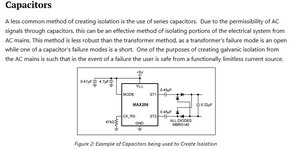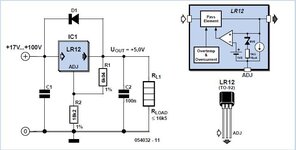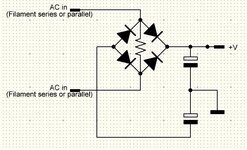neazoi
Advanced Member level 6
Regarding the transformer, such mini audio interstage transformers have an iron core http://img.tradeindia.com/fp/1/001/175/371.jpg wouldn't they be ok for low current drawing at 50-60Hz? Or maybe a 600:600 modem transformer. These are small to fit inside the tube body. But will this solve the problems with the filaments mentioned above? I think that yes, because there is a real resistance at the windings. However on series filaments sets, one would expect all the filaments to run on the same current. And the transformer current will be different from that of the tubes filaments.It would have to be a 'real' transformer so probably too big to fit in the tube base.
An alternative idea along the same lines might be to use a bridge rectifier but instead of taking one side of its output to chassis, use it to power a miniature isolated power supply then take the output of that to chassis.
I'm thinking of something like this:
They are quite small but you do still need to ensure the voltage fed into it is fairly stable.
Brian.
Regarding the "instead of taking one side of its output" comments, this gives me an idea, that of the virtual ground. How about connecting the bridge outputs to two series capacitors. One will serve as a negative end and the other as positive. In the middle point of the capacitors, it will be the virtual ground. Is is this virtual ground that will then be used for the eye. Will it do any good or am I thinking nonsense here?
--- Updated ---
About the virtual ground I mean something like the schematic on the right. (on the left there was the real ground one)Regarding the transformer, such mini audio interstage transformers have an iron core http://img.tradeindia.com/fp/1/001/175/371.jpg wouldn't they be ok for low current drawing at 50-60Hz? Or maybe a 600:600 modem transformer. These are small to fit inside the tube body. But will this solve the problems with the filaments mentioned above? I think that yes, because there is a real resistance at the windings. However on series filaments sets, one would expect all the filaments to run on the same current. And the transformer current will be different from that of the tubes filaments.
Regarding the "instead of taking one side of its output" comments, this gives me an idea, that of the virtual ground. How about connecting the bridge outputs to two series capacitors. One will serve as a negative end and the other as positive. In the middle point of the capacitors, it will be the virtual ground. Is is this virtual ground that will then be used for the eye. Will it do any good or am I thinking nonsense here?
The chassis ground and the eye circuit ground are isolated (at least on DC). The "grid" voltage that fed to the solid state eye, is now referenced to the virtual ground. This means that it will be half, from 6v to 3v. I can bring my circuit to work down to 3v, this is not a problem.
But will it work now and avoid the limitations we discussed above? (different filament configurations)?
Attachments
Last edited:



